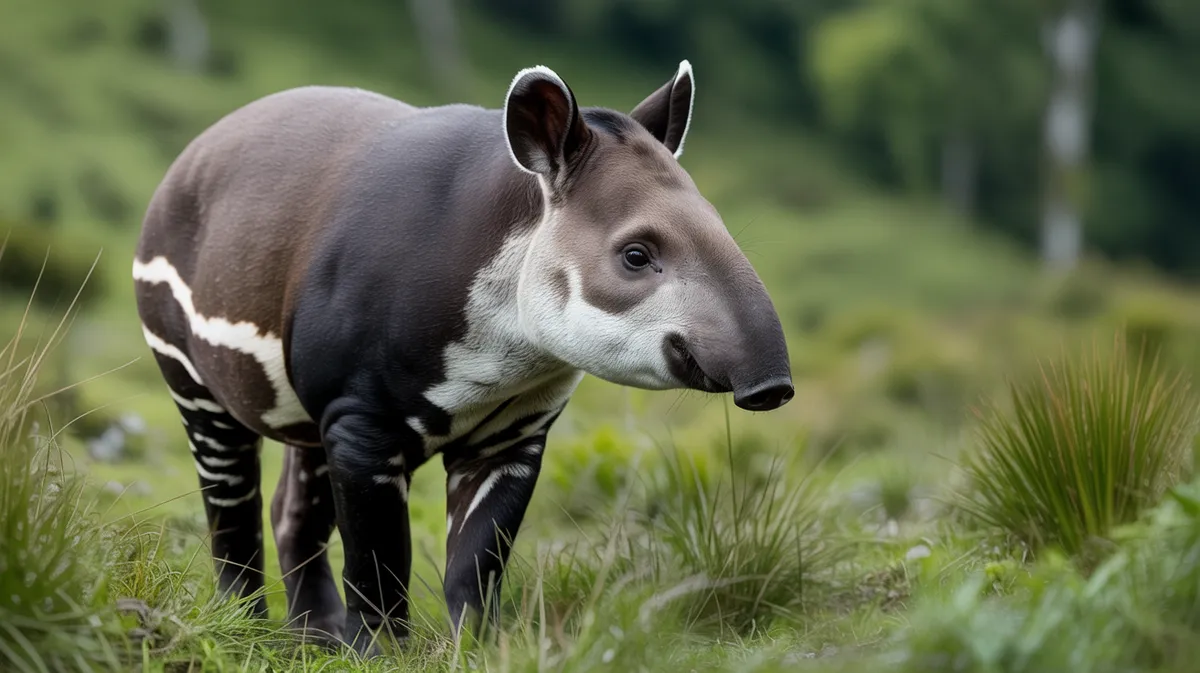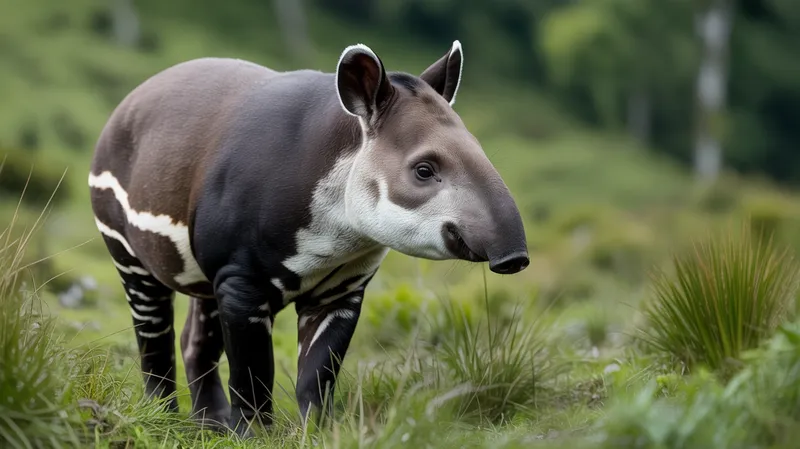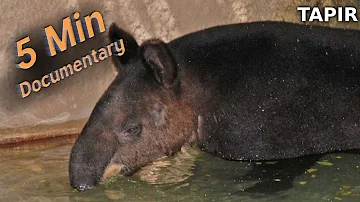
Mountain Tapir
Tapirus pinchaque

Meet the Mountain Tapir
The Mountain Tapir is the smallest and most endangered of the four tapir species, native to the cloud forests and páramo of the northern Andes in Colombia, Ecuador, and northern Peru. Recognizable by its thick, woolly blackish-brown fur and white lips, it is well adapted to colder, high-altitude environments. This solitary, nocturnal herbivore plays a vital role in its ecosystem by dispersing seeds and promoting forest regeneration. Unfortunately, habitat loss and hunting have caused significant population declines, making conservation efforts crucial for its survival.
Classification
Mammal
Habitat
Andean cloud forests and páramo (high-altitude grasslands)
Diet
Herbivore
Lifespan
20-30 years
Conservation
Endangered
Weight
136–250 kg (300–550 lbs)
📖Fascinating Facts
Forest Gardener
Mountain Tapirs disperse seeds through their droppings, aiding the regeneration and diversity of Andean forests.
Cold Climate Adaptation
Their thick, woolly fur is unique among tapirs, providing insulation against the high-altitude cold.
Solitary Wanderer
They are mostly solitary and have large home ranges, often traveling many kilometers in search of food.
📋Detailed Description
The mountain tapir (Tapirus pinchaque) is a medium-sized perissodactyl mammal, typically measuring 180–250 cm in length and standing 75–90 cm at the shoulder, with adults weighing between 136 and 250 kg. It is distinguished from other tapir species by its dense, woolly, dark brown to blackish fur, which provides insulation against the cold, wet climates of the Andean cloud forests and páramo. The species has a distinctive white band around the lips and sometimes white-tipped ears, features that may aid in individual recognition. Its prehensile snout is highly flexible and sensitive, allowing the animal to grasp and manipulate a wide variety of vegetation, including leaves, shoots, fruits, and bromeliads. Mountain tapirs are primarily crepuscular and nocturnal, spending daylight hours concealed in dense vegetation or resting in mud wallows. They are solitary for most of the year, except during mating or when females are accompanied by offspring. Their home ranges are large, often spanning several square kilometers, and they use well-established trails through their territory. The species plays a crucial ecological role as a keystone seed disperser, promoting forest regeneration and plant diversity. Their thick skin and robust build provide some protection from predators, which include pumas and spectacled bears, though predation is rare for adults.
💡 Did you know?
The Mountain Tapir is considered a 'flagship species' for Andean forest conservation due to its ecological importance and endangered status.
🔬Research & Sources
Wikipedia Summary
The mountain tapir, also known as the Andean tapir or woolly tapir, is the smallest of the four widely recognized species of tapir. It is found only in certain portions of the Andean Mountain Range in northwestern South America. As such, it is the only tapir species to live outside of tropical rainforests in the wild. It is most easily distinguished from other tapirs by its thick woolly coat and white lips.
Last Modified: 5/17/2025
🎭Behavior & Social Structure
Mountain tapirs are generally solitary, with individuals maintaining overlapping home ranges but rarely interacting outside of the breeding season. They are most active during twilight and nighttime hours, foraging for a diverse diet of over 200 plant species, including ferns, shrubs, and fruiting trees. Feeding behavior involves using their prehensile snout to strip leaves or pluck fruits, and they are known to travel considerable distances nightly in search of food. Tapirs are adept swimmers and often use water bodies for bathing, thermoregulation, and escape from predators. They communicate with a range of vocalizations, including whistles, squeals, and snorts, as well as scent marking via urine and feces to establish territory. Wallowing in mud is a common behavior, serving to deter ectoparasites and regulate body temperature. Despite their generally shy and elusive nature, mountain tapirs may become aggressive if threatened, using their strong jaws and sharp teeth for defense.
👶Reproduction & Life Cycle
Mountain tapirs are polygynous, with males seeking out receptive females during the breeding season, which may occur year-round but peaks during the rainy season (November to April). Courtship involves vocalizations, scent marking, and physical contact. After mating, the gestation period lasts approximately 13 months (390–400 days), resulting in the birth of a single calf. Newborns weigh about 5–7 kg and are characterized by a reddish-brown coat with white stripes and spots, providing camouflage in dappled forest light. Calves are precocial, able to stand and follow their mother within hours of birth. The mother provides extensive care, nursing the calf for up to 6 months, though the young may remain with her for up to 18 months before becoming fully independent. Sexual maturity is reached at 3–4 years of age. Reproductive rates are low, with females typically producing a single offspring every 2–3 years, contributing to the species’ vulnerability.
🛡️Adaptations & Survival
The mountain tapir exhibits several unique adaptations to its high-altitude, cool, and humid environment. Its thick, woolly fur insulates against cold temperatures and frequent rainfall found at elevations of 2,000–4,300 meters. The dark coloration aids in heat absorption and camouflage among dense vegetation. The prehensile snout is a specialized adaptation for selective browsing in a diverse plant community. Large, splayed hooves provide stability and traction on steep, muddy, or rocky slopes. Physiologically, mountain tapirs have a relatively slow metabolism and efficient digestive system, allowing them to extract nutrients from fibrous, low-calorie vegetation. Their keen sense of smell and hearing compensate for relatively poor eyesight, aiding in predator detection and foraging. Behavioral adaptations include nocturnality and secretive habits, which reduce predation risk and human encounters.
📚Research Sources
🎨Cultural Significance
In local Andean cultures, the mountain tapir is sometimes regarded as a symbol of wilderness and ecological health. While not as prominent in folklore as the jaguar or condor, it occasionally appears in indigenous myths as a guardian of the forest or as a spirit animal. In some regions, tapir body parts have been used in traditional medicine, believed to confer strength or healing. Conservation organizations have used the mountain tapir as a flagship species to promote awareness of Andean biodiversity and the importance of preserving high-altitude ecosystems.
🔬Recent Research & Discoveries
Recent research has focused on the mountain tapir’s role as a keystone seed disperser, with studies demonstrating its importance for the regeneration of Andean forests and maintenance of plant diversity. Genetic analyses have revealed low genetic diversity in some populations, highlighting the need for habitat connectivity. Camera trap and GPS collar studies have provided new insights into home range size, movement patterns, and habitat preferences, informing conservation planning. Ongoing research is investigating the impacts of climate change on habitat suitability and the effectiveness of protected areas. Conservation genetics, disease surveillance, and community-based monitoring are emerging areas of study, aiming to enhance long-term survival prospects for the species.
🎥Wildlife Videos

Mountain Tapir Forever Documentary
A short documentary explaining the Mountain Tapir Forever Project in San Agustín, Huila, Colombia. This project aims to conserve ...
TAPIR WORLD

Tapir - 5 Minute Documentary
Embark on a captivating journey into the lush rainforests and serene savannas with a five-minute documentary that delves into the ...
Five Minute Documentaries

Esperanza - The Mountain Tapir
The Real Truth and Cost of Coffee and Chocolate. The connections in South America with a large animal you've probably never ...
brockinitiative

Curious Mountain Tapirs
Tapirs are living fossils because they haven't changed significantly since its origins back in the early Eocene of North America.
TAPIR WORLD

Costa Rica’s Wildest Creatures
Flashback to 2018, Danielle ventures into the jungles of Costa Rica in search of it's majestic wildlife. Come face to face with a ...
Animalogic

Mountain Tapirs (Tapirus pinchaque) at natural salt lick
In Tungurahua province, Ecuador, there is a group of natural mineral springs which attract the endangered Mountain Tapir ...
EcoMinga Foundation
🌍Habitat Information
The Mountain Tapir typically inhabits Andean cloud forests and páramo (high-altitude grasslands) environments. Mountain Tapirs have adapted to their environments with specialized features and behaviors.
Primary Habitat:
Andean cloud forests and páramo (high-altitude grasslands)
More detailed habitat information will be available soon.
🛡️Conservation Status
The Mountain Tapir is currently classified as Endangered. Conservation efforts are crucial for preserving this species for future generations.
Common Threats:
- 🏠Habitat loss and fragmentation
- 🌡️Climate change impacts
- 🎯Hunting and poaching
- 🏭Human-wildlife conflict
⚠️Threats & Conservation Challenges
The mountain tapir faces severe threats from habitat loss and fragmentation due to agricultural expansion, cattle grazing, mining, and infrastructure development in the Andes. Illegal hunting for meat and traditional medicine, as well as accidental snaring, further reduce populations. Climate change poses an emerging threat, altering the distribution of cloud forests and páramo, potentially reducing suitable habitat. With an estimated wild population of fewer than 2,500 mature individuals and declining, the species is classified as Endangered by the IUCN. Small, isolated populations are at risk of inbreeding depression and local extinctions. Conservation challenges include limited protected area coverage, insufficient law enforcement, and lack of public awareness. Ongoing efforts focus on habitat protection, community engagement, anti-poaching patrols, and ecological research to inform management.
🔬Scientific Classification
Scientific Name
Tapirus pinchaque
Classification Hierarchy
🔍 About Taxonomic Classification
Taxonomic classification is a hierarchical system used by scientists to classify and organize living organisms based on shared characteristics and evolutionary relationships.
The system moves from broad categories (Kingdom) to increasingly specific ones, with each animal's scientific name typically consisting of its Genus and species.
📝Community Notes
Share your observations and insights about the Mountain Tapir with our community of wildlife enthusiasts.
Join Our Community
Sign in to share your observations and connect with fellow wildlife enthusiasts.
Sign In to ContributeNo community notes yet
Be the first to share your observations about the Mountain Tapir!
Explore Mountain Tapir
Select a tab above to learn more about this amazing animal.
📸Photo Gallery
No photos available for this animal yet.
🌟Discover More Wildlife
Continue your journey of discovery with more fascinating animals from our database
